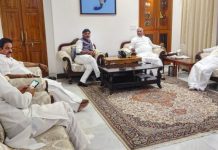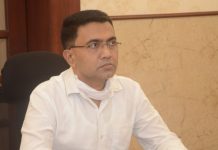
MADKAM DEVA is a tribal, the sort characterised romantically in social science schoolbooks and museum artifacts illustrative of India’s remotest jungle peoples. There is nothing charming though about the chilling tale of a bloodbath he recalls staccato, walking barefoot as always in the sprawling southern forests of Chhattisgarh, waving at the deep red blood clots thickened on fallen leaves, still enough food in them for frenzied golden ants two weeks after human gore was spilled here. Deva’s blood would be here, too, had he not ducked the machinegun fire in a nanosecond, leapt behind the shrubbery like frightened deer, and bolted through the cascading landscape.
“They made us stand in a line and ordered us to bow our heads,” Deva says of those terrifying moments between life and death. “I was the last and that gave me just enough time to escape.”
Four more proved lucky. But 19 others did not. A posse made largely of men from the Salwa Judum (literally, Peace Gathering), the tribal militia raised by the state as a quasi police force, killed 15 men and four women at this spot on the afternoon of January 8, 2009, triggering a massive furor across the state and worsening the battle lines between the armed Maoist insurgents, popularly called the Naxals, and the state police.
Immediately, the police named the killings a huge — and rare — success in their grim and often adverse battle against the Naxals who, for three decades, have had a free run of some 15,000 sq km in Bastar, the traditional name for the vast heavily forested tribal region that now encompasses five districts in south Chhattisgarh. “Our fight to the finish has begun,” Chhattisgarh Home Minister Nanki Ram Kanwar told TEHELKA in the state capital, Raipur, this week. “We will soon reoccupy our lands that the Naxals have controlled for decades.”
[box]
WHAT HAPPENED: THE POLICE VERSION
The Salwa Judum SPOs had intelligence that Naxals were to meet near Singaram
The 84-strong SPO party patrolled the area without entering any village
At 4pm, as they crossed Singaram, a group of Naxals opened gunfire on them
The SPOs retaliated with heavy firing, and the encounter lasted 90 minutes
15 of the “outer layer” of Naxals were killed. But the “hardcore” cadre escaped. Rifles, grenades and other arms were recovered
The SPOs left the bodies behind and returned with the collected weapons
[/box]

NANKI RAM KANWAR
Home Minister, Chhattisgarh
That may be long in the coming, if at all. For now, the rebels have reacted strongly, slamming the killings and vowing revenge in banners, pamphlets and posters distributed across the region; calling successful general shutdowns; blocking highways by digging up roads and cutting trees; and burning trucks. A massive cry has gone up across the state’s tribal region, among human rights groups, and from the opposition Congress and Communist parties, rejecting the police claims, alleging instead that those killed were innocent villagers picked up forcibly from their homes, marched into the woods, and shot in cold blood. “All the dead bodies were found lying together, which wouldn’t be the case if this was a genuine encounter,” says Manish Kunjum of the Communist Party of India (CPI), a three-term ex-MLA who organised a massive protest rally of thousands of tribal people.

EMLA HUNGA
Survivor, Danteshpura village
The state High Court has stepped in, too, demanding full facts from the police, after some 20 relatives of those killed, reached by an NGO in their remote villages, walked 70km and then bussed 500km to Chhattisgarh’s northern city of Bilaspur to file a petition before the Court seeking a probe into the killings. Says Kopa Kunjum, a human rights activist with the NGO Vanvasi Chetna Ashram, who walked two days to the remote villages to bring these relatives to the city: “By all accounts, those killed did not have weapons. This was a one-way shootout; only the police had the guns.”

MADKAM MUDRAJ
Ex-Naxal, now Salwa Judum SPO
TESTIMONIES TEHELKA has gathered from extensive travels in the Naxal-controlled territory over a week suggest that the police story might be just that: a story. We extensively interviewed three of the five men who claim they survived the bloodbath; the kin of eight of those killed; and many villagers who claim they witnessed the Salwa Judum enter four villages and abduct 24 people.
We walked four hours to the remote village of Singaram, from where four of those killed were allegedly abducted, and spoke over two days with their relatives and other witnesses. We spoke to them individually, grilling them at length, checking especially to see if the truth indeed lay in the police version — that a Naxal group fired on the Salwa Judum patrol, forcing it to retaliate, and that the villagers’ narrative was a false one thrust upon them by the Naxals. Apart from the survivors, we took a dozen villagers to the scene of the killings some three kilometres from Singaram, and heard them describe their visits there the day after the killing to locate the dead. Such testimonies largely corroborate each other.

ANKIT ANAND
SDM in charge of probe
On the other hand, there are discrepancies in the narratives of two individuals TEHELKA spoke to from the police. One is Rahul Sharma, IPS, who is the Superintendent of Police (SP) of Dantewada, the district in which Singaram falls and which is one of the state’s two most heavily Naxal affected districts.Sharma directly planned the January 8 incursion into the Singaram region, the deepest the police or its militias have ever gone in the Naxal territory in Chhattisgarh. The second is Kichche Nanda, 27; the plucky leader of the militia-police combine who claims his 84-men team ran into the Naxals and killed them.
Importantly, though the survivors and the relatives of those killed vehemently deny links with the Naxals, several others, including those who allege that the Salwa Judum militia shot defenceless people in cold blood, concede the police claim that at least a few of those killed were indeed the “outer layer” of the Naxals or were closely linked to the Maoists. “It is known that Sitakka alias Seetey worked with the Naxals,” said a villager requesting anonymity, referring to the woman killed who the police claim was the leader of the group that was killed. “She had trained in providing medical care to the Naxals.”

MANISH KUNJUM
CPI leader & ex-MLA
Here’s what the survivors of the gunfire and other villagers claim happened on January 8, 2009. Around 9am, a group of 150 to 200 men wearing battle fatigues and carrying guns entered a village named Danteshpura, and immediately began ransacking its homes. Here, they abducted nine people, including two women, and forced them to carry their backpacks. “They told us they will take us to a police station 30km away and then let us go,” says Emla Hunga, one of the five survivors. “We believed them and started walking with them.” Of this group of nine, only Hunga survived the subsequent massacre. His brother, who was also abducted, died.
Before noon, this party had reached another village named Korrusguda. Here, they picked up a woman and eight men, including Madkam Deva, one of the five who escaped the bloodbath and is quoted at the beginning of this report. Deva was atop his granary near his hut when two men jumped him. These nine, too, were made to carry backpacks. Finally, by 3pm, the abductors and their hostages reached Singaram. Here, four more were caught, including Sitakka, who the police say led the “Naxal group”.
Shortly after leaving Singaram, the party stopped by a forest stream three kilometres ahead. “They asked us to rest here, saying they will give us food,” recalls Hunga. But that was not to be. Instead, the militia opened the backpacks and took out shirts and trousers. They forced seven men to discard their lungis, the tribal people’s wraparound, and wear trousers. They were also forced to wear shirts over their vests. One man was forced to wear a battle fatigue. The militia then divided the hostages in three groups. Fifteen men, including Deva, were moved away in one direction. Four women, one of whom was taken hostage moments ago as she was walking past, were taken to another corner. Hunga and four others were forced to stay by the stream.
“We heard the women scream, then gunshots, then silence,” Deva recalls. Between the gunshots and the screams, he saw the abductors go into batches towards where the women were taken. Says Emla Harma, still sitting by the stream, who later escaped: “The women cried out for their mothers a long time.”

KOPA KUNJUM
Activist, Vanvasi Chetna Ashram
THESE TESTIMONIES, and those of the villagers’ who fetched the dead the next day and claim the women’s bodies were partially or fully naked, have brought the allegation that the women were raped before they were killed. Some of the pictures of the dead bodies taken by journalists from nearby towns of Andhra Pradesh, who visited the scene of the killings a day later, indeed showed the women’s clothes disheveled, even in a state of undress.
After the women were killed, the 15 men were lined up between the trees. Soon, bullets were flying around. Fourteen died instantly. Deva alone escaped. That left the party of five men, still by the stream, stricken with fear. The abductors now forced these five men to lift the backpacks and start walking again in a file. Harma led the queue. Hunga was number four. “Suddenly, one of the gunmen stepped to a side and opened fire,” says Hunga. “I turned and saw blood gushing from the man behind me.” In a flash, the other four threw the backpacks and darted in the forest, surviving the hail of bullets chasing after.
The five survivors reached their respective villages late at night and shared their harrowing tales. By then, Dantewada’s SP, Sharma, had gone public with the claim that his men had killed 15 Naxals in an encounter near Singaram. The next morning, scores of villagers descended on the scene of the killings. So did the journalists from Andhra Pradesh, who extensively took pictures of the dead and went back to write the first stories questioning the police claim of an “encounter”. Sharma told TEHELKA the police had seized 10 backpacks, five rifles, five hand grenades, two 2-inch country-made mortars, 6kg gelatin, and some “bomb-making material”. These were presented before the media at a police station the next day.

Photo: File Pictures
Survivors Hunga and Deva had recognised up to four of the men in the Salwa Judum. They are called Special Police Officers (SPOs). The survivors say these four SPOs are tribal people from other villagers, and once worked with the Naxals but later crossed over to the Salwa Judum. They include Madkam Mudraj, who confirmed to TEHELKA he was indeed once a child Naxal soldier but was now an SPO and had played a key role in the January 8 killings.
The police, on the other hand, claim that this party of Salwa Judum SPO and some regular policemen had been patrolling the region since the night of January 6. “We were walking in two groups apart by 500m when the Naxals saw one group and started firing at it,” says Nanda, who led the patrol. The Naxals, he says, were in the middle of the two groups of SPOs and this made them sitting ducks. But there are discrepancies:
• Sharma says the group had 54 SPOs and 30 policemen. Nanda says they were 74 SPOs and five policemen with four others.
• Sharma says the “police party generated intelligence at village Danteshpura that a large quantity of ration had moved towards Singaram village”. But Nanda said his party did not enter any of the villages or talk to anyone there.
• Sharma says three men received body injuries. But, when pressed, Nanda said one man was injured on his palm, while the other two “fainted because they were shooting on hungry stomachs”. Within a week, the one with the palm injury had returned to work.
• Sharma admits the arms recovered are old but says that’s because the “hardcore” Naxals, who use sophisticated guns, had run away quickly leaving behind only the “outer layer”. But Nanda says the encounter lasted 90 minutes with massive firing from both sides.
• Inexplicably, Nanda, who had an AK47, only fired 15 rounds in 90 minutes. He says he didn’t need to shoot more as “I shoot only if I can see a person”. Yet he couldn’t say if he killed anyone.
[box]
WHAT HAPPENED: SURVIVORS’ TALES
150-200 SPOs entered four villages, looted them, and abducted 24 people
The hostages were forced to carry backpacks and walk over 15km
Just outside Singaram, the SPOs forced seven men to wear shirts and trousers
Marched ahead, 4 women were heard screaming until gunshots rang out
15 men were lined up and shot at. 14 died but one, Madkam Deva, escaped
The five remaining men were made to walk again with backpacks. Four of them escaped as one was shot dead
[/box]
So, how come not a single SPO died or even received gunshots? Why did the SPOs, who numbered over 80, not carry with them the 15 dead bodies they claim to have counted on the spot? Why don’t the police carry out tests on the body of Sitakka, which lies buried in Singaram, to establish if she was raped?
For now, Ankit Anand, an IAS officer in his first posting at Dantewada as a sub-divisional magistrate, is holding a “magisterial inquiry”. He has visited Singaram and recorded 24 statements, both from the villagers and the police-SPOs. His mandate is to establish (a) whether the police had “sufficient reason” to believe they were Naxals and (b) whether the police had “sufficient chance” to catch them without killing them. He says he has found “different points of view” in the testimonies. “Prima facie we may feel that they are contradictory,” he says, “but in the end, we will get a story that is generally coherent.” Just how?












